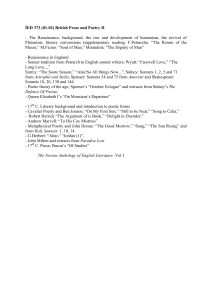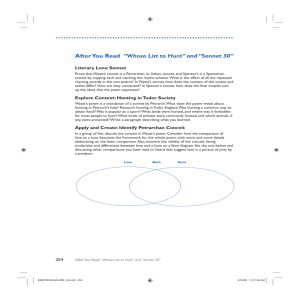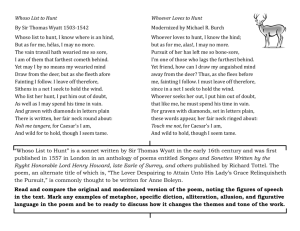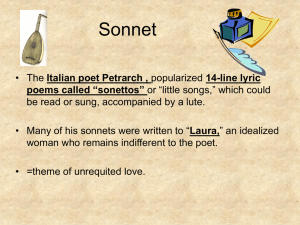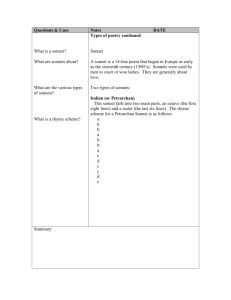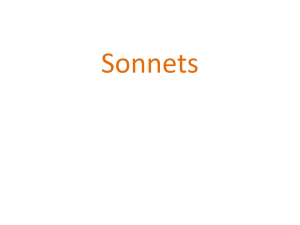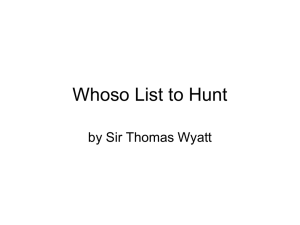Whoso List to Hunt Sir Thomas Wyatt Sonnets 30 and 75 Edmund
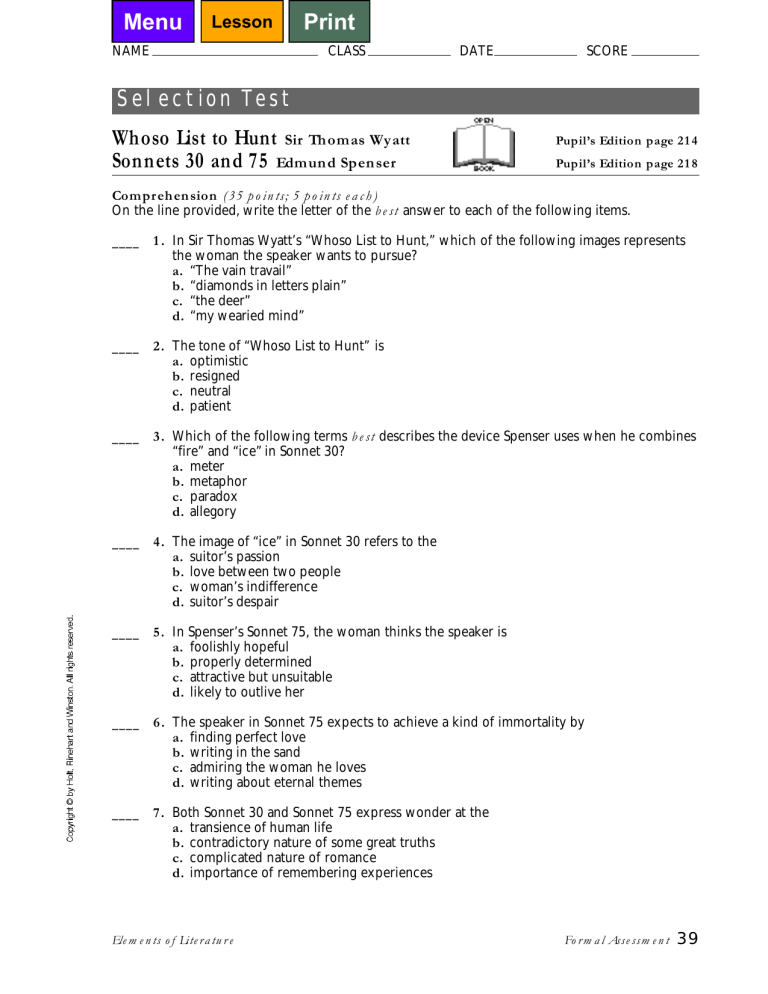
Menu
NAME
Lesson Print
CLASS DATE SCORE
Selection Test
Whoso List to Hunt
Sir Thomas Wyatt
Sonnets 30 and 75
Edmund Spenser
Pupil’s Edition page 214
Pupil’s Edition page 218
Comprehension (35 points; 5 points each)
On the line provided, write the letter of the best answer to each of the following items.
____ 1.
In Sir Thomas Wyatt’s “Whoso List to Hunt,” which of the following images represents the woman the speaker wants to pursue?
a.
“The vain travail” b.
“diamonds in letters plain” c.
“the deer” d.
“my wearied mind”
____ 2.
The tone of “Whoso List to Hunt” is a.
optimistic b.
resigned c.
neutral d.
patient
____ 3.
Which of the following terms best describes the device Spenser uses when he combines
“fire” and “ice” in Sonnet 30?
a.
meter b.
metaphor c.
paradox d.
allegory
____ 4.
The image of “ice” in Sonnet 30 refers to the a.
suitor’s passion b.
love between two people c.
woman’s indifference d.
suitor’s despair
____ 5.
In Spenser’s Sonnet 75, the woman thinks the speaker is a.
foolishly hopeful b.
properly determined c.
attractive but unsuitable d.
likely to outlive her
____ 6.
The speaker in Sonnet 75 expects to achieve a kind of immortality by a.
finding perfect love b.
writing in the sand c.
admiring the woman he loves d.
writing about eternal themes
____ 7.
Both Sonnet 30 and Sonnet 75 express wonder at the a.
transience of human life b.
contradictory nature of some great truths c.
complicated nature of romance d.
importance of remembering experiences
Elements of Literature Formal Assessment
39
Menu Lesson
CLASS
NAME DATE SCORE
Literary Elements
On the line provided, write the letter of the best answer to each of the following items.
Poetic Meter (20 points; 10 points each)
____ 8.
Poetic meter is a.
the manner in which a poem is read b.
metaphysical extended metaphors c.
literary conceits that rhyme d.
regular patterns of syllables
____ 9.
What is the poetic foot of the words “in love”?
a.
trochee b.
iamb c.
anapest d.
dactyl
Petrarchan and Spenserian Sonnets (20 points; 10 points each)
____ 10.
“Whoso List to Hunt” is a a.
Spenserian sonnet b.
Petrarchan sonnet c.
Shakespearean sonnet d.
Petrarchan conceit
____ 11.
How are Sonnets 30 and 75 different from “Whoso List to Hunt”?
a.
Sonnets 30 and 75 have three four-line stanzas and a concluding couplet.
b.
Sonnets 30 and 75 have four couplets and a concluding sestet.
c.
Sonnets 30 and 75 have two conceits and a concluding octave.
d.
Sonnets 30 and 75 have six couplets and two quatrains.
Written Response (25 points)
12.
On a separate sheet of paper, write a paragraph in which you discuss how “Whoso List to
Hunt,” Sonnet 30, or Sonnet 75 would change if the main conflict did not exist. Would there still be a poem? If so, what would the poem’s message be? Support your ideas with at least two details from the chosen poem.
40
Formal Assessment Elements of Literature
